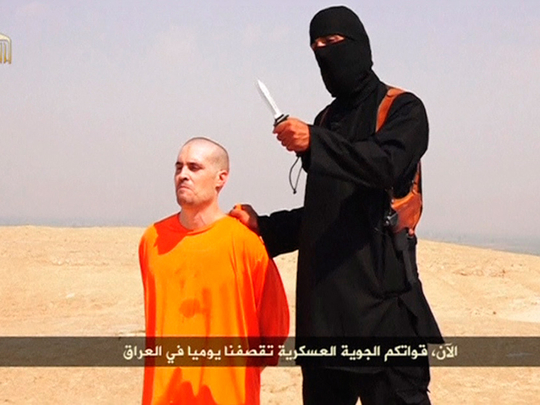
LONDON: Militants from Islamic State of Iraq and the Levant (Isil) claimed to have killed an American journalist long held captive in Syria in retaliation for ongoing US air strikes against its forces in Iraq.
A propaganda video circulated on Tuesday showed a masked Isil fighter beheading a kneeling man dressed in an orange jumpsuit who is purported to be James Wright Foley, a photojournalist who went missing in Syria in 2012.
The masked executioner spoke in English, with what sounded like a British accent, and said the slaying came in response to the air strikes ordered by President Barack Obama against Isil 12 days ago.
Isil, whose chief spokesman came under US state department sanctions on Monday, warned of further revenge — including on another man purported to be a captured US journalist, Steven Sotloff — and in the video the victim was made to read a statement blaming the US for his own murder.
Foley has been missing in Syria since November 2012, where he went to report on the bloody struggle to overthrow dictator Bashar Al Assad. He was initially thought to have been captured by forces loyal to the Al Assad regime.
After the video came out a Facebook message from a support group, Free James Foley, urged patience “until we all have more information”, and asked that readers “keep the Foleys in your thoughts and prayers”.
Foley’s mother later released a statement saying her son gave his life to expose the suffering of the Syrian people. Diane Foley asked his kidnappers to release their other captives.
“He was an extraordinary son, brother, journalist and person,” she said.
“We implore the kidnappers to spare the lives of the remaining hostages. Like Jim, they are innocents. They have no control over American government policy in Iraq, Syria or anywhere in the world.
“We have never been prouder of our son Jim. He gave his life trying to expose the world to the suffering of the Syrian people.”
YouTube took down the gruesome video, but not before it sparked a debate on social media about the ethics of sharing it, adding a metatextual debate to a depiction of a man’s violent death.
Foley, 40, a former Stars and Stripes reporter, was captured in November 2012 near the Syrian town of Taftanaz. It was not his first detention while reporting: in 2011, he was taken while reporting on the uprising against Libyan dictator Muammar Gaddafi. Gaddafi’s forces ultimately released him after six weeks in captivity.
A friend of Foley’s and his fellow captive in Libya, journalist Clare Morgana Gillis, wrote in a 2013 essay that captivity was “the state most violently opposite his nature.” Gillis described Foley as gentle, friendly, courageous and impatient with “anything that slows his forward momentum.”
In a January 2013 interview with local television news near her Rochester, New Hampshire home, Foley’s mother Diane said her son was “passionate about covering the story in Syria, passionate about the people there.”
Caitlin Hayden, the spokeswoman for the National Security Council, said US intelligence was working to determine the authenticity of the video.
“If genuine, we are appalled by the brutal murder of an innocent American journalist and we express our deepest condolences to his family and friends,” Hayden said in a statement.
A day after Obama declared that Iraqi and Kurdish forces backed by US warplanes had broken Isil’ hold on the critical Mosul Dam, US Central Command announced two strikes near it on Monday, to “further expand control of the area.” One strike was said to have destroyed an Isil checkpoint while the other was “not successful.”
Obama has offered no timeframe for the length of his campaign against Isil. The US military has bombed over 90 targets attributed to Isil, including vehicle convoys, mobile artillery and fixed positions, since August 8. Most of the strikes have come in the past few days, near the dam. The other strikes have occurred either to blunt an Isil advance on the Kurdish regional capital of Arbil or to lift an Isil siege on Mount Sinjar, where it chased thousands of Iraqi Yazidis whom it threatened to kill unless they converted to Islam. The US considers the siege broken.












